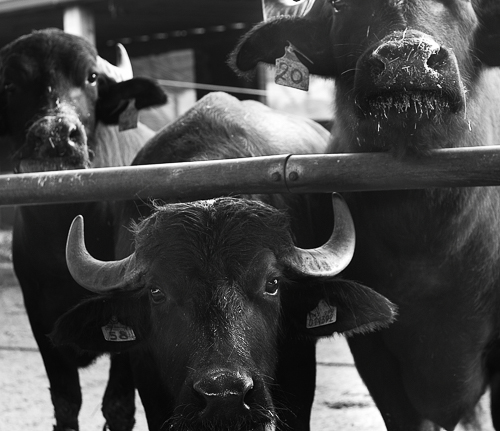The farm was started in 1939 by the marquis Antonio Trionfi Honorati who wanted to found a farmhouse dairy using milk from 30 Friesian cows. The farm has been owned by the Trionfi Honorati family ever since, and it is now being managed by the siblings Giulia and Antonio. Giulia is in charge of the farmhouse dairy and the well-stocked farm shop residing in the same building, while Antonio looks after the animals, whose number has grown to more than 300, consisting of both Friesian cows and buffaloes.
The animals
The farm has 190 cows, Dutch Friesian and 150 buffaloes. They are born in a special room and the birth may last up to a day for the cows, while it is very quick affair for the buffaloes.
The calves are staying in separate rooms for 3 months until they are weaned off cow’s milk. They receive milk from their mothers for the first four days because it’s important that the first milk they are drinking are from their mothers in order to reinforce their immune system. Thereafter, they are fed powder milk.
The health of the calves has to be controlled regularly. The young cows have to do 4 shifts from room to room, while the young buffaloes have to do only 3 shifts because they are less in need of controlling their health. The calves of the buffaloes are able to stand upright after only 20 minutes after birth because they are still preserving their wild characteristics.
The first insemination takes place when the cows are about 15-17 months depending on the development of the animal. The cows are always artificially inseminated, while this happens very seldom with the buffaloes. Instead, the farm’s bull called Ciccio is doing this job.
The buffaloes originate from Syria, coming to Italy during the barbaric invasions and found favourable environments in present Puglia and Campania. 70 buffaloes arrived at the farm in April 2004.
The customers are buying the meat of the calves, especially the male ones. The meat of the buffaloes is exceptional and it contains lots of iron and little cholesterol. Naturally, quality of the meat depends on the fodder.
Both maize, soy, oats and hay are grown at the farm and the animals are given a mix of these cereals. The farn has a mill where grinding and mixing of the cereals are carried out.
All the animals live in sheds all year. The owner, Antonio Trionfi, would like to release the animals to a pasture, but, unfortunately, there are people who open the fences surrounding the pasture permitting the animals to escape.
The milking of the cows is automated and the cows are milked twice daily. The Dutch Friesian cows are producing about 20 litres a day, while the buffaloes are producing about 8 litres. The milk of the buffaloes, containing about 8% fat, is not bottled.
Photographing the animals was interesting: the Friesian cows seemingly didn’t care about being photographed, while the buffaloes cared very much. All of them were very curious and even those who were lying down, ruminating, arose and looked at me curiously.
The cheeses
Even though the cheeses are made from the same milk, it’s possible to produce many different types of cheese. The types depend on, among other things:
- temperature
- type of coagulated milk
- salting
- container in order to shape the cheeses
- maturation
- type of cut
About 30 types of products, many of which are not traditional, are made at the dairy. Some of them are listed below:
- buffalo ricotta
- soft cheeses and cacetto
- buffalo yogurt
- buffalo vanilla ice cream
- mozzarella
- robioline
- primosale- sheep’s cheese
- stracchinella
- caciottina, ‘pasta filata’ style cheese with truffles
The farm has also a shop where the public can buy products from the dairy and other products mainly from the Marches. The customers are buying everything which is produced and it seems like the demand is greater than the supply.

